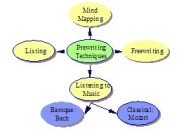Mind Mapping: A Key Technique for Learning
Mind mapping helps you generate ideas, create associations, and open up your capacity to learn and create.
In The Mind Map Book: How to Use Radiant Thinking to Maximize Your Brain's Untapped Potential
, English author and educator Tony Buzan writes:
Each bit of information entering your brain—every sensation, memory or thought (incorporating every word, number, code, food, fragrance, line, colour, image, beat, note and texture) can be represented as a central sphere from which radiate tens, hundreds, thousands, millions of hooks.
Each hook represents an association, and each association has its own infinite array of links and connections. The number of associations you have already ‘used’ may be thought of as your memory, your database, your library.
Mind maps can range from simple black and white circles connected to each other by straight lines to complex diagrams in multiple colors and varying line thicknesses. They may include words alone or incorporate an array of symbols and pictures.
Where to Use the Technique
This tool is a wonderful way to make connections, discover hidden aspects of a topic, and increase your creativity. It's my favorite technique for creating associations because it combines the visual aspects of our brains with the verbal.
You can use this technique to:
- Quickly generate ideas before you start to write an article, essay or book.
- Visually plan and synthesize an entire book, course, or project.
- Take notes during a lecture or summarize a chapter in a textbook.
For Example: Use It as a Prewriting Technique

Just one way in which you can use this technique is to generate ideas before you begin to write.
To get started, write a word or phrase in the middle of a page and draw a circle around it. (The example uses Prewriting Techniques.)
As your mind starts to make associations, write your ideas next to the first word and draw circles around them, too. (The example uses Listing, Listening to Music, Mindmapping and Freewriting.) Then draw a line between the first circle and the second tier of circles to connect them.
When you have finished, look at the ideas in the second tier of circles and begin associating ideas with them. (The example uses Listening to Music and adds the additional ideas of Baroque: Bach and Classical: Mozart.)
Continue with this process until you have generated plenty of ideas to work with.
iMindMap Software
If you would like to discover some great software--authorized by Tony Buzan--that makes this process particularly fun and easy, click on the image below:

Return to Learning Strategies
Return Home from Mind Mapping



